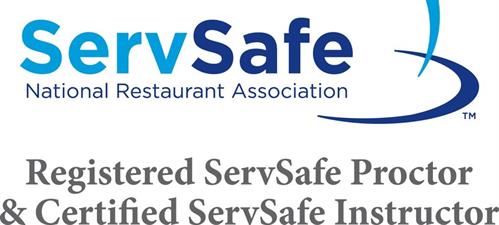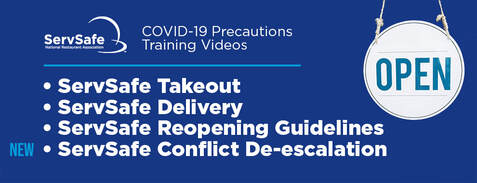Quick Tips for Effectively Finishing Your ServSafe Food Handler Training Course Online
Wiki Article
Comprehensive Food Handlers Training for Hygiene and Security
In today's quickly progressing food solution landscape, thorough food trainers training has actually arised as a critical component for guaranteeing hygiene and safety. By instilling important methods associated with hand hygiene, food storage, and sanitation, this training not only mitigates the risk of foodborne illnesses yet additionally enhances conformity with regulative requirements. The ramifications of such training extend beyond plain conformity; they discuss public health and wellness and customer count on. Yet, the efficiency of these training programs can vary significantly. What aspects really determine their success in fostering a society of security?Value of Food Safety Training

In addition, food security training aids to make sure that staff members recognize existing regulations and guidelines, which are essential for preserving functional licenses and staying clear of costly charges. Normal training sessions also act as a system for reinforcing best methods, therefore decreasing the probability of human mistake, which often acts as a leading source of food contamination.
In addition, buying food safety training can improve an establishment's online reputation, as consumers increasingly prioritize dining experiences that show high security criteria. Such aggressive actions not only protect consumers but likewise add to the long-lasting success of food services. In recap, detailed food safety and security training is an indispensable element of food service operations, straight influencing both public wellness and business sustainability.
Trick Concepts of Health
Keeping high requirements of health is necessary in any type of food managing atmosphere to avoid contamination and guarantee the security of consumers. The key concepts of health include a number of crucial practices that food handlers have to continually use.First, hand hygiene is paramount; food trainers must wash their hands thoroughly with soap and water prior to and after taking care of food, in addition to after using the restroom or touching any kind of potentially contaminated surface areas. Tools and surface areas need to be consistently cleaned up and sanitized to remove microorganisms. This includes tools, cutting boards, and kitchen counters, which ought to be kept in a clean problem.


Appropriate food storage is additionally important; raw foods should be saved individually from prepared or ready-to-eat products to avoid cross-contamination. servsafe alcohol. Furthermore, keeping ideal temperature controls is important; perishable things ought to be maintained at risk-free temperature levels to inhibit bacterial development
Lastly, individual hygiene can not be forgotten. Food handlers must use tidy clothing, usage hair restrictions, and avoid functioning when ill. By sticking to these essential concepts of hygiene, food handlers can dramatically lower the danger of foodborne ailments and promote a more secure eating experience for all consumers.
Usual Foodborne Illnesses
Although lots of foodborne health problems can be stopped via proper health and risk-free food managing techniques, they stay a considerable public health and wellness concern. Foodborne virus can cause a range of ailments, ranging from light gastrointestinal distress to extreme complications and even death.Typical foodborne ailments consist of salmonellosis, brought on by Salmonella bacteria, often connected to undercooked poultry and eggs. One more widespread illness is listeriosis, linked with unpasteurized dairy items and ready-to-eat meats, which can be particularly hazardous for expectant females and immunocompromised people. Norovirus, frequently gotten from contaminated food or surfaces, is recognized for its quick spread and ability to trigger outbreaks in communal settings.
Escherichia coli (E. coli) infection, significantly connected with undercooked hamburger and contaminated fruit and vegetables, can cause extreme abdominal cramps and kidney failure in many cases. In addition, Clostridium perfringens, commonly found in large amounts of food that are poorly saved, can create food poisoning with signs and symptoms appearing shortly after intake.
Recognizing these diseases is crucial for food trainers, as recognition can dramatically reduce the risk of contamination and protect public health and wellness. Appropriate education and training are crucial components in combating foodborne conditions.
Best Practices for Food Handling
Reliable food handling methods are essential in stopping the spread of foodborne ailments. Proper hand hygiene is crucial; food handlers have to wash their hands thoroughly with soap and water prior to and after dealing with food, specifically raw meat or poultry. This straightforward action dramatically decreases the threat of cross-contaminationSecondly, preserving appropriate food storage temperature levels is important. Subject to spoiling items must be stored at or below 40 ° F(4 ° C) to hinder bacterial development. In addition, cooked foods must be maintained above 140 ° F(60 ° C) up until offered.
Thirdly, guaranteeing sanitation of surfaces and equipment is critical. Routinely sterilize kitchen counters, cutting boards, and utensils, especially after preparing raw foods. Usage different cutting boards for ready-to-eat and raw foods to even more decrease contamination threats.
Moreover, when preparing food, it is essential to follow the principle of "first in, first out" (FIFO) to manage inventory efficiently and decrease putridity. Finally, always read and adhere to food item tags for secure cooking temperatures and taking care of directions. By applying these ideal methods, food handlers can considerably enhance food safety and security and shield public health and wellness.
Executing a Safety Society
Developing a security culture within a food taking care of setting is necessary for promoting a commitment to food safety and security among all team member. This culture emphasizes the relevance of food security as a shared duty, motivating employees to focus on hygiene techniques constantly.To execute a safety and security society, organizations must begin by giving detailed training that addresses food handling procedures, potential dangers, and the importance of individual hygiene. Educating sessions should be interactive and customized to the specific duties of employee, guaranteeing importance and engagement.
In addition, leadership plays an essential role in developing this society. Administration needs to model risk-free techniques and communicate the value of food safety and security frequently. Identifying and rewarding workers that copyright security criteria can further reinforce these habits.
In addition, open communication channels should be developed, servsafe permitting staff to report security worries without anxiety of repercussion. Regular security audits and comments sessions can aid recognize locations for improvement and strengthen responsibility.
Inevitably, growing a safety and security society not just boosts compliance with food safety regulations but likewise safeguards public health and wellness, promotes worker morale, and adds to the general success of the food managing establishment.
Conclusion
In verdict, thorough food trainers training plays a crucial duty in advertising health and security within food service establishments. By equipping employees with essential knowledge about food security concepts, typical foodborne diseases, and best practices for taking care of food, such training dramatically lowers health and wellness dangers. Cultivating a society of safety boosts the establishment's credibility and straightens with customer expectations for high safety and security requirements, inevitably adding to public health defense and the overall success of the food solution market.In today's swiftly progressing food service landscape, detailed food handlers training has actually emerged as an essential element for ensuring health and safety and security.Food security training is crucial for preserving high standards in food handling and prep work, with researches suggesting that correct training can decrease foodborne ailments by up to 30%. In summary, detailed food safety training is a vital element of food service procedures, directly affecting both public wellness and business sustainability.

Report this wiki page